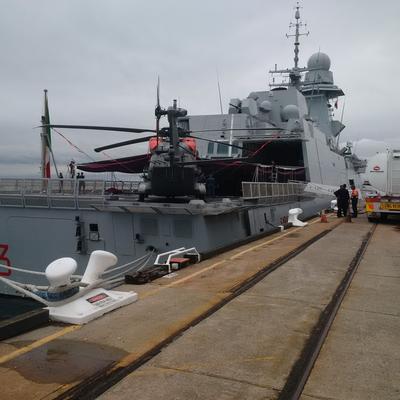Fincantieri's proposal for the Sea 5000 Future Frigate is based upon the Italian version of the European FREMM (FRegata Europea, Multi-Missione).
Nigel Pittaway | Melbourne
Updated 05:40 February 12 2017
More specifically, the Australian variant will be based upon the Italian Navy Anti-Submarine Warfare variant, rather than the similar but more austere General Purpose version.
Known as the Bergamini class, the Italian FREMM is four metres longer than the French equivalent and, at around 6,600 tonnes, has a displacement 600 tonnes greater. The original program called for eight ships to be built, but options on a further two have since been exercised.
Four Bergamini frigates had been delivered and two more are undergoing final completion, having been launched in December 2014 and 2015 respectively. Construction of the final two vessels is also underway at Fincantieri’s shipyard in Riva Trigoso, for delivery in April 2018 and 2019.
Propulsion is combined diesel-electric and gas turbine (CODLAG), providing a speed in excess of 27 knots and a range in excess of 6,000 nautical miles.
The Bergamini class has two hangars, capable of operating either two NH90 NFH or one NH90 and one AW101 helicopters.
Weapons include a 76mm OTO Melara Super Rapido gun fore and aft on the ASW variant, and an OTO Melara 127mm gun forward and 76mm gun aft on the General Purpose vessel. A 16-cell vertical launch system (VLS) is fitted, but the ship is designed to accommodate a further 16 cell module if required. Primary ASW sensors are hull-mounted Thales UMS 4110 CL low frequency active and passive sonar and a Thales CAPTAS 4249 towed-array sonar.
Fincantieri says the general hull configuration of the Bergamini ASW will require little or no modification to meet Sea 5000 requirements, with the only likely modifications being the replacement of the 76mm forward gun with a 127mm (5-inch) unit and installation of other mandated equipment such as CEA radars and possibly the Saab 9LV combat system.
The General Purpose variant already has the larger calibre weapon on the foredeck, so Fincantieri says the switch will not present any issues, unless Navy mandates the US Navy 5-inch gun, in which case some redesign will be required.
![By Bahnfrend (Own work) [CC BY-SA 4.0 (http://creativecommons.org/licenses/by-sa/4.0)], via Wikimedia Commons](http://res.cloudinary.com/yaffa-publishing/image/fetch/v1486837550/http://yaffa-cdn.s3.amazonaws.com/adm/images/dmImage/SourceImage/Carabiniere_F593_Fremantle_2017_03_web_825D42A0-F087-11E6-B6CC4AF2C3D73C2A.jpg) Italian frigate Carabiniere (F593), on display at Victoria Quay, in the inner harbour of the Port of Fremantle, WA, during her visit in January 2017. Credit: Bahnfrend CC BY-SA 4.0 via Wikimedia Commons
Italian frigate Carabiniere (F593), on display at Victoria Quay, in the inner harbour of the Port of Fremantle, WA, during her visit in January 2017. Credit: Bahnfrend CC BY-SA 4.0 via Wikimedia Commons
Likewise the Italian FREMM has a large structure atop the mast, housing the Selex radar systems. A Fincantieri spokesman said that initial discussions have been held with CEA Technologies and that no problems are foreseen either mounting the local radars, or providing power and cooling to them. The spokesperson also said the ships’ Operations Room has adequate space and provision for the 9LV combat system.
Italian ships have a 21-berth accommodation module fitted aft of the VLS system and should additional cells be specified as planned, their installation will come at the expense of the additional accommodation. In Italian service the ship has a complement of 133, swelling to 156 with two helicopters embarked but, with 200 bunks onboard, the loss of 21 bunks still leaves a reasonable margin.
Australian Construction
Speaking at the 2016 ADM Congress in February senior vice president of Fincantieri’s Washington operations, Chuck Goddard, pointed to the industry models the Italian shipbuilder has already established around the world.
These strategies ranged from full ‘turnkey’ construction in Italy (or delivered to the customer for system installation) through to the establishment of partnerships with local industry (as done in Greece, India, Turkey and Peru) or the establishment of a local presence through acquisition of a foreign company in order to design and construct ships locally, is it has done in Brazil, the UAE and the US.
 “Fincantieri is ready to establish strategic partnerships with the Australian shipbuilding industry, and we have a long history of doing that, in addition to helping to train the workforce and the management, to maximise the possible benefits associated with this important economic sector, transferring its experience in conducting past and current shipbuilding programs in the customer’s country,” Goddard said.
“Fincantieri is ready to establish strategic partnerships with the Australian shipbuilding industry, and we have a long history of doing that, in addition to helping to train the workforce and the management, to maximise the possible benefits associated with this important economic sector, transferring its experience in conducting past and current shipbuilding programs in the customer’s country,” Goddard said.
A Fincantieri spokesman said that it has no problem with the concept of manufacturing modules in other Australian shipyards, before bringing them to Adelaide for consolidation, pointing out that the company already does this on the Italian FREMM program.
The Marina Militare's FREMM frigate Carabiniere alongside in Adelaide with her SH90 displayed on the flight deck. Credit: ADM (Philip Smart)




![ITS Carabiniere during her earlier visit to Fremantle. Credit: Bahnfrend (Own work) [CC BY-SA 4.0 (http://creativecommons.org/licenses/by-sa/4.0)], via Wikimedia Commons](http://yaffa-cdn.s3.amazonaws.com/adm/images/dmImage/StandardImage/Carabiniere_F593_Fremantle_2017_03_web_825D42A0-F087-11E6-B6CC4AF2C3D73C2A.jpg)
